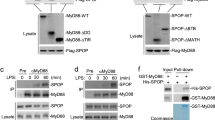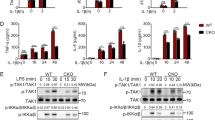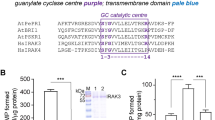Abstract
Interleukin-1 (IL-1) is a proinflammatory cytokine that elicits its pleiotropic effects through activation of the transcription factors NF-κB and AP-1. Binding of IL-1 to its receptor results in rapid assembly of a membrane-proximal signalling complex that consists of two different receptor chains (IL-1Rs), IL-1RI and IL-1RAcP, the adaptor protein MyD88, the serine/threonine kinase IRAK and a new protein, which we have named Tollip. Here we show that, before IL-1β treatment, Tollip is present in a complex with IRAK, and that recruitment of Tollip–IRAK complexes to the activated receptor complex occurs through association of Tollip with IL-1RAcP. Co-recruited MyD88 then triggers IRAK autophosphorylation, which in turn leads to rapid dissociation of IRAK from Tollip (and IL-1Rs). As overexpression of Tollip results in impaired NF-κB activation, we conclude that Tollip is an important constituent of the IL-1R signalling pathway.
This is a preview of subscription content, access via your institution
Access options
Subscribe to this journal
Receive 12 print issues and online access
$209.00 per year
only $17.42 per issue
Buy this article
- Purchase on Springer Link
- Instant access to full article PDF
Prices may be subject to local taxes which are calculated during checkout






Similar content being viewed by others
References
Hoffmann, J. A., Kafatos, F. C., Janeway, C. A. & Ezekowitz, R. A. Phylogenetic perspectives in innate immunity. Science 284, 1313–1318 (1999).
Wilson, I., Vogel, J. & Somerville, S. Signalling pathways: a common theme in plants and animals? Curr. Biol. 7, R175–R178 (1997).
Wesche, H., Henzel, W. J., Shillinglaw, W., Li, S. & Cao, Z. MyD88: an adapter that recruits IRAK to the IL-1 receptor complex. Immunity 7, 837–847 (1997).
Burns, K. et al. MyD88, an adapter protein involved in interleukin-1 signaling. J. Biol. Chem. 273, 12203–12209 (1998).
Muzio, M., Ni, J., Feng, P. & Dixit, V. M. IRAK (Pelle) family member IRAK-2 and MyD88 as proximal mediators of IL-1 signaling. Science 278, 1612–1615 (1997).
Wesche, H. et al. The interleukin-1 receptor accessory protein (IL-1RAcP) is essential for IL-1-induced activation of interleukin-1 receptor-associated kinase (IRAK) and stress-activated protein kinases (SAP kinases). J. Biol. Chem. 272, 7727–7731 (1997).
Cao, Z., Henzel, W. J. & Gao, X. IRAK: a kinase associated with the interleukin-1 receptor. Science 271, 1128–1131 (1996).
Wesche, H. et al. IRAK-M is a novel member of the Pelle/interleukin-1 receptor-associated kinase (IRAK) family. J. Biol. Chem. 274, 19403–19410 (1999).
Yamin, T. T. & Miller, D. K. The interleukin-1 receptor-associated kinase is degraded by proteasomes following its phosphorylation. J. Biol. Chem. 272, 21540–21547 (1997).
Cao, Z., Xiong, J., Takeuchi, M., Kurama, T. & Goeddel, D. V. TRAF6 is a signal transducer for interleukin-1. Nature 383, 443–446 (1996).
Song, H. Y., Regnier, C. H., Kirschning, C. J., Goeddel, D. V. & Rothe, M. Tumor necrosis factor (TNF)-mediated kinase cascades: bifurcation of nuclear factor-kappaB and c-jun N-terminal kinase (JNK/SAPK) pathways at TNF receptor-associated factor 2. Proc. Natl Acad. Sci. USA 94, 9792–9796 (1997).
Baud, V. et al. Signaling by proinflammatory cytokines: oligomerization of TRAF2 and TRAF6 is sufficient for JNK and IKK activation and target gene induction via an amino-terminal effector domain. Genes Dev. 13, 1297–1308 (1999).
Nalefski, E. A. & Falke, J. J. The C2 domain calcium-binding motif: structural and functional diversity. Protein Sci. 5, 2375–2390 (1996).
Huang, J., Gao, X., Li, S. & Cao, Z. Recruitment of IRAK to the interleukin-1 receptor complex requires interleukin-1 receptor accessory protein. Proc. Natl Acad. Sci. USA 94, 12829–12832 (1997).
Volpe, F. et al. The IL-1 receptor accessory protein is responsible for the recruitment of the interleukin-1 receptor associated kinase to the IL-1/IL-1 receptor I complex. FEBS Lett. 419, 41–44 (1997).
Maschera, B., Ray, K., Burns, K. & Volpe, F. Overexpression of an enzymically inactive interleukin-1-receptor-associated kinase activates nuclear factor-kappaB. Biochem. J. 339, 227–231 (1999).
Li, X. et al. Mutant cells that do not respond to interleukin-1 (IL-1) reveal a novel role for IL-1 receptor-associated kinase. Mol Cell Biol 19, 4643–4652 (1999).
Shen, B. & Manley, J. L. Phosphorylation modulates direct interactions between the Toll receptor, Pelle kinase and Tube. Development 125, 4719–4728 (1998).
Kojima, H. et al. Interleukin-18 activates the IRAK–TRAF6 pathway in mouse EL-4 cells. Biochem. Biophys. Res. Commun. 244, 183–186 (1998).
Acknowledgements
We thank R. MacDonald for EL-4 6.10 cells, M. Muzio for Myc-tagged IRAK-2, J. White for pYTH9, T. Roger for Flag-tagged mTLR2 and mTLR4, H. Kojima for IL-18R, E. Qwarnstrom, C. J. Caunt and O. Micheau for localization studies with Tollip and P. Schneider and R. Budd for critical reading of the manuscript. We also thank R. Brown, S. Farrow, S. Lens, N. Holler and M. Kovacsovics for discussions and for support for this project.
Correspondence and requests for materials should be addressed to J.T. The amino-acid sequences of mouse and human Tollip have been deposited at GenBank under accession numbers AJ242971 and AJ242972, respectively. The amino-acid sequence of human Tollip is a conceptual translation assembled using expressed-sequence tag (EST) accession numbers AA773650, T19084, AA452030, AI126693, AA984561, R22358, AA430274, AA190644, R14385, AI078838, AI391687, D62608, AA49595, AI202790, AA443337, AA188666, AA533680, AL041203, AI434615 and R21855. The amino-acid sequence of C.elegans Tollip is derived from accession number Z79754 using genewise (http://www.sanger.ac.uk/Software/Wise2/Programming).
Author information
Authors and Affiliations
Corresponding author
Rights and permissions
About this article
Cite this article
Burns, K., Clatworthy, J., Martin, L. et al. Tollip, a new component of the IL-1RI pathway, links IRAK to the IL-1 receptor. Nat Cell Biol 2, 346–351 (2000). https://doi.org/10.1038/35014038
Received:
Revised:
Accepted:
Published:
Issue Date:
DOI: https://doi.org/10.1038/35014038
This article is cited by
-
TOLLIP inhibits lipid accumulation and the integrated stress response in alveolar macrophages to control Mycobacterium tuberculosis infection
Nature Microbiology (2024)
-
Toll-interacting protein may affect doxorubicin resistance in hepatocellular carcinoma cell lines
Molecular Biology Reports (2023)
-
The nuclear cytokine IL-37a controls lethal cytokine storms primarily via IL-1R8-independent transcriptional upregulation of PPARγ
Cellular & Molecular Immunology (2023)
-
Gestational heat stress alters skeletal muscle gene expression profiles and vascularity in fetal pigs in a sexually dimorphic manner
Journal of Animal Science and Biotechnology (2022)
-
Toll-interacting protein impacts on inflammation, autophagy, and vacuole trafficking in human disease
Journal of Molecular Medicine (2021)



